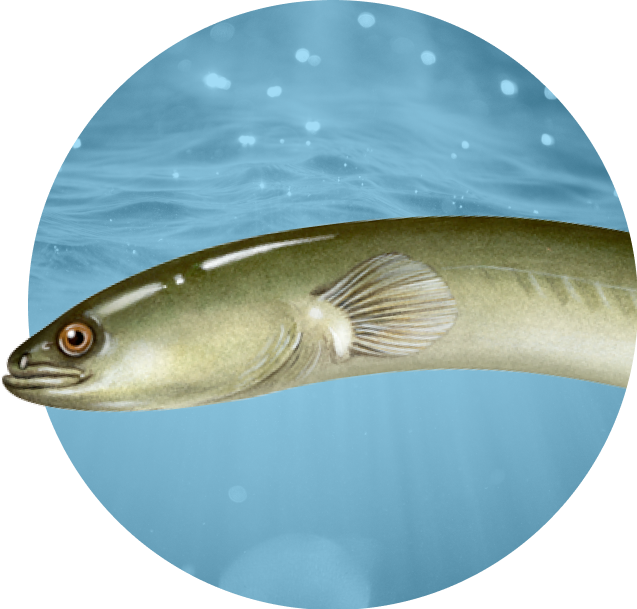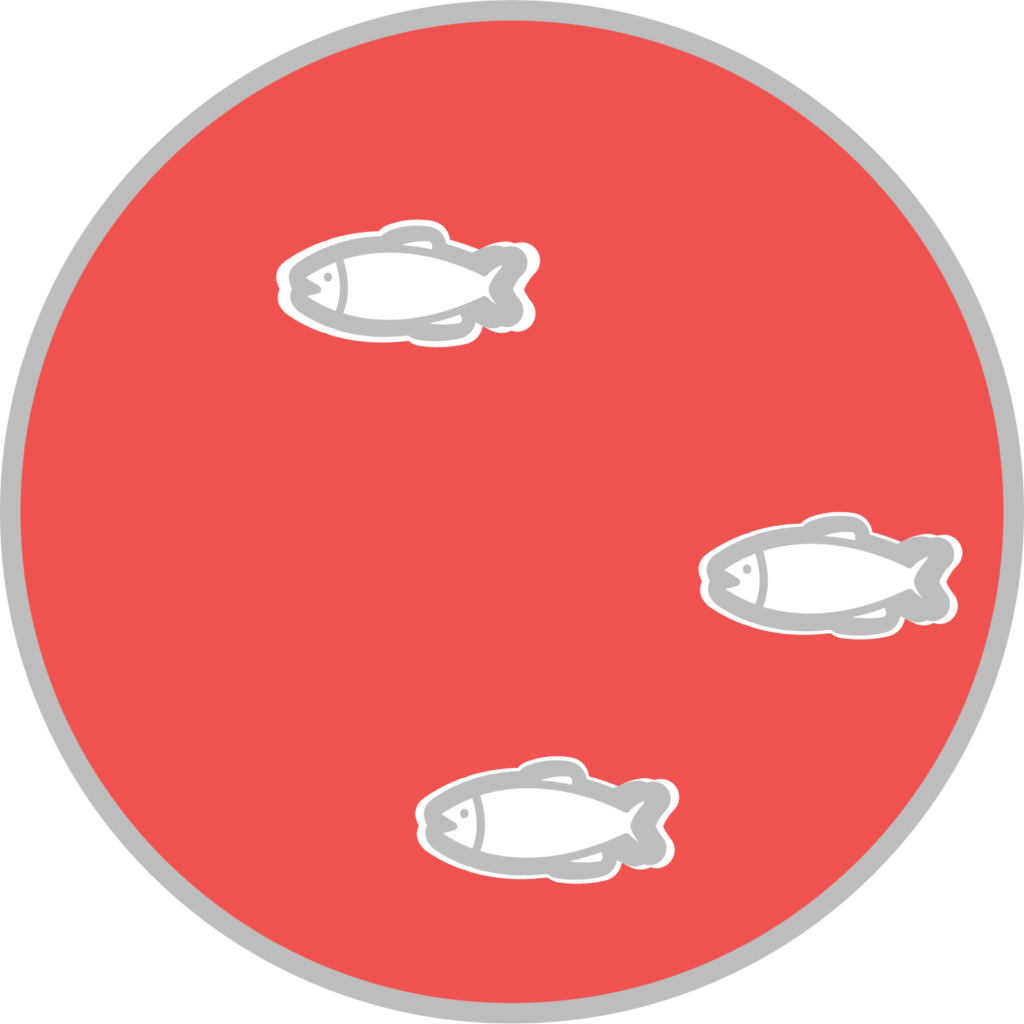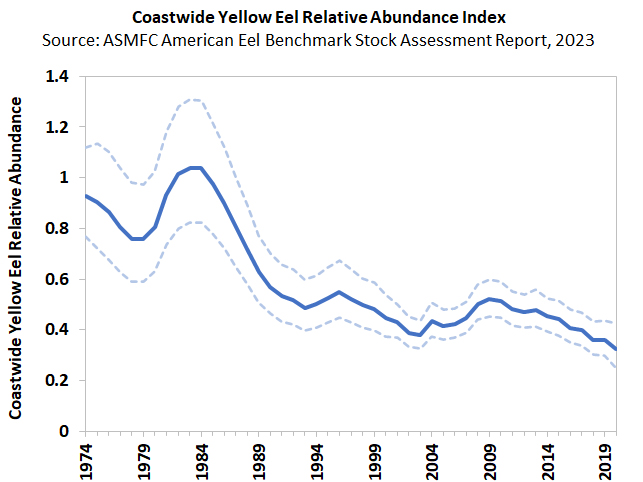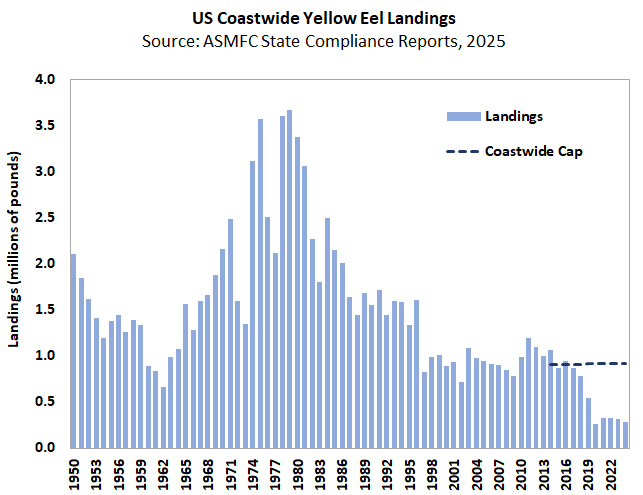American Eel

Latest News and Resources
-

Population Abundance
Depleted

Fishing Mortality
Unknown
Current Status
Stock status based on trend analysis in 2023 benchmark stock assessment. Coastwide yellow eel harvest cap reduced to 518,281 pounds based on assessment and continued population decline. Maine’s glass eel quota set at 9,688 pounds for 2025-2027.
Meeting Calendar
Next Meeting
No events found
Contacts
- Caitlin Starks, Senior FMP Coordinator (CStarks@asmfc.org)
- Management Board, Jesse Hornstein, Chair
- Technical Committee, vacant, Chair
- Advisory Panel, Mitch Feigenbaum, Chair
Species Information
The American eel is a unique and challenging species to manage due to its complex life cycle and broad habitat range, spanning from freshwater rivers to the Sargasso Sea. As a vital part of the Atlantic coastal ecosystem and a resource for commercial and recreational fisheries, its population has faced significant declines due to overfishing, habitat loss, and environmental changes. Through collaborative efforts, the Commission continues to implement adaptive management strategies to conserve and rebuild this important species.
Management
American eel are challenging to conserve and manage on a coastwide basis for a number of reasons. During their life-span American eel navigate through and reside in a wide range of habitats, from the oceanic waters of the Sargasso Sea to the brackish waters of coastal estuaries and the inland freshwater river systems. Additionally, throughout this journey, eel exist under a myriad of management authorities, including international and multiple federal, state and local governments. Life history characteristics such as late age of maturity and a tendency to aggregate during certain life stages further complicate conservation efforts.
American eel’s management is coordinated by the Commission in state coastal inshore and inland waters along the Atlantic coast from Maine to Florida. Increasing demand for eel by Asian markets and domestic bait fisheries, coupled with concern about declining eel abundance and limited assessment data, spurred development of the first Interstate Fishery Management Plan (FMP) for American Eel in the mid-1990s. The plan, approved in 1999, provided several reasons why heavy harvest pressure may adversely affect American eel populations: (1) American eel have a slow rate of maturation, requiring eight to 24+ years to attain sexual maturity; (2) glass eel tend to aggregate seasonally during migration, making them vulnerable to directed harvest; (3) harvest of yellow eel is a cumulative stress, over multiple years, on the same year class; and (4) all fishing mortality occurs prior to spawning.
In response to the 2012 stock assessment, which indicated that the American eel population in U.S. waters is depleted, the Commission approved Addendum III (August 2013) and Addendum IV (October 2014) to the Interstate FMP with the goal of reducing mortality and increasing conservation of American eel stocks across all life stages. Addendum III established new management measures for both the commercial (glass, yellow, and silver) and recreational eel fisheries, and implements fishery-independent and fishery-dependent monitoring requirements. Addendum IV established a 907,671 pound coastwide quota for yellow eel fisheries, reduced Maine’s glass eel quota to 9,688 pounds (2014 landings), and allowed for the continuation of New York’s silver eel weir fishery in the Delaware River.
In 2018, Addendum IV provisions were replaced by Addendum V, which increases the yellow eel coastwide cap starting in 2019 to 916,473 pounds; adjusts the method (management trigger) to reduce total landings to the coastwide cap when the cap has been exceeded; and removes the implementation of state-by-state allocations if the management trigger is met. Under Addendum V, management action will now be initiated if the yellow eel coastwide cap is exceeded by 10% in two consecutive years. If the management trigger is exceeded, only those states accounting for more than 1% of the total yellow eel landings will be responsible for adjusting their measures. A workgroup will be formed to define the process to equitably reduce landings among the affected states when the management trigger has been met.
Addendum V, implemented January 1, 2019, also slightly modified the glass eel aquaculture provisions. It maintained the 200-pound limit for glass eel harvest but modified the criteria for evaluating the proposed harvest area’s contribution to the overall population consistent with the recommendations of the Technical Committee. Under the revised provisions, the Board approved Maine’s glass eel aquaculture proposal for the 2019 fishing season, allowing for an additional 200 pounds of glass eels to be harvested for development in domestic aquaculture facilities. This amount is in addition to Maine’s glass eel quota.
Addendum VI, approved in April 2024, maintains Maine’s glass eel quota of 9,688 pounds originally established under Addendum IV. The Board also approved Addendum VII in April 2024. Addendum VII responds to the stock assessment findings that the American eel stock is depleted and the yellow eel population has continued to decline. Addendum VII set the coastwide yellow eel harvest cap to 518,281 pounds using an index-based method that provides management advice based on abundance indices and catch information, as well as management goals specified by the Board. It also modifies biological sampling requirements of the annual young-of-the-year survey and the de minimis policy.
Stock Status
From a biological perspective, much is still unknown about American eel. Information is limited about their abundance, status at all life stages, and habitat requirements. According to the 2023 stock assessment, the American eel population remains depleted in U.S. waters. The stock is at or near historically low levels due to a combination of historical overfishing, habitat loss, food web alterations, predation, turbine mortality, environmental changes, toxins and contaminants, and disease.

Based on several trend analyses, abundance the stock is considered depleted, consistent with the findings of the 2012 and 2017 assessments. The 2023 stock assessment found that the yellow eel population was at lower levels than the previous assessment, and yellow eel harvest should be decreased. Trend analyses of abundance indices indicated large declines in abundance of yellow eels during the 1980s through the early 1990s, with primarily neutral or stable abundance from the mid-1990s through 2010, followed by further declines. Total landings remain low but stable. No overfishing determination can be made based on the analyses performed. The results of the 2023 Benchmark Stock Assessment and Peer Review were accepted for management use in August 2023.
In 2011, the US Fish and Wildlife Service (USFWS) initiated a status review of American eel under the Endangered Species Act (ESA) to assess the health of the population and the magnitude of threats facing the species. On October 7, 2015, USFWS announced that the American eel is stable and does not need protection under the ESA. Nonetheless, for the species’ long-term stability, the agency recommends continuing efforts to maintain healthy habitats, monitor harvest levels, and improve river passage for migrating eels. In 2014, the International Union for the Conservation of Nature (IUCN) listed American eel as “Endangered” on the Red List. The IUCN assesses flora and fauna globally to determine their conservation status (not evaluated to extinct). While the IUCN list has no legal implications, it is an important metric that accounts for a variety of factors including habitat, threats, potential stresses, and research status. Given these findings, and recent actions taken by the Commission and its member states, the Commission remains committed to closely monitoring American eel fisheries and the status of the resource, and making adjustments to the management program as necessary, to ensure stock rebuilding.
Commercial & Recreational Fisheries
American eel are an important resource from both a biodiversity and human use perspective. They serve as an important prey species for many fish, aquatic mammals and fish-eating birds. Although US fisheries have significantly contracted from historical levels, eel support valuable commercial fisheries as well as small-scale recreational and subsistence fisheries.

From the 1970s to the mid-1980s, American eel supported significant commercial fisheries, with landings ranging from 2.5 to 3.6 million pounds. Yellow eel landings dropped to 1.6 million pounds in 1987 and have remained at low levels, ranging from 1.5 million to a record low of under 220,000 pounds in 2020. State-reported landings of yellow eels in 2024 totaled approximately 284,625 pounds, which is a 3.8% decrease from 2023. The commercial yellow eel fishery is primarily concentrated in the Mid-Atlantic states.
Since 2011, there has been a growing international demand for glass eels (an early life stage of American eel) for aquaculture purposes, which has increased landings and the price per pound of glass eels. Only Maine and South Carolina have glass eel fisheries; in 2023, Maine harvested 9,634 pounds of glass eel and South Carolina harvest remained below 750 pounds.
Recreational harvest has declined since its peak in 1985 at 160,000 eel. Harvest was last estimated to be around 6,000 eel in 2009 (the last year the Marine Recreational Information Program collected recreational data on American eel). Given the small scale of the fishery in recent years, there is limited monitoring of recreational catch by the states.
Life History
American eel (Anguilla rostrata) are a catadromous fish species, spending most of their life in freshwater or estuarine environments, traveling to the ocean as adults to reproduce and die. Sexually maturing eel migrate to spawning grounds located in the Sargasso Sea, a large portion of the western Atlantic Ocean east of the Bahamas and south of Bermuda. American eel are a panmictic stock, meaning that individuals from the entire range come together to reproduce. American eel found along the eastern coast of Mexico are from the same population as eel found in the St. Lawrence River in Canada.
American eel development includes several life stages: leptocephali, glass eel (also known as elvers), yellow eel, and silver eel. The life cycle begins when the eggs hatch and leptocephali (larvae) are carried by ocean currents from the spawning grounds in the Sargasso Sea. The leptocephali metamorphose into glass eel on the continental shelf. Glass eel swim upstream to reach estuarine and freshwater habitats, sometimes hundreds of miles upriver, becoming pigmented elvers before or during their entry into coastal estuaries. Elvers and yellow eel spend between 3 and 30 or more years in estuarine or freshwater habitats. American eel reach the silver stage at maturity and return to the Sargasso Sea, where they spawn and die. Yellow eel are the primary life stage harvested by commercial and recreational fishermen.
News & Resources
Explore recent news, management updates, and scientific reports to gain a deeper understanding of ongoing conservation efforts and sustainability strategies.
-
The Atlantic States Marine Fisheries Commission’s Winter Meeting will be February 4 – 5, 2025 at The Westin Crystal City.
-
-
Commissioner Manual
-
A summary of all the board meetings, press releases and motions from the 2025 Annual Meeting.
-
-
-
Consider Approval of Fishery Management Plan Review and State Compliance for 2024 Fishing Year (C. Starks); Consider Florida Proposal to Discontinue Young-of-Year Sampling (E. Burgess)
-
-
-
A summary of all the board meetings, press releases and motions from the 2025 Summer Meeting.
-
-
The American Eel Management Board of the Atlantic States Marine Fisheries Commission convened in the Jefferson Ballroom of the Westin Crystal City Hotel, Arlington, Virginia, via hybrid meeting, in-person and webinar; Tuesday, August 5, 2025, and was called to order at 1:30 p.m. by Chair Kristopher M. Kuhn.
-
Update on CITES Proposal to List American Eel under Appendix II; Review and Consider Maine Aquaculture Plan for 2026 Fishing Year and Technical Committee Report
-
Combined materials for all Boards convening at the ASMFC Summer Meeting
-
Review of Maine Aquaculture Plan and TC Recommendations
Get Hooked on ASMFC News
Dive into the latest updates and catch all the important news by joining our newsletter mailing list. Stay in the loop with meeting agendas, fisheries management news, and more.








